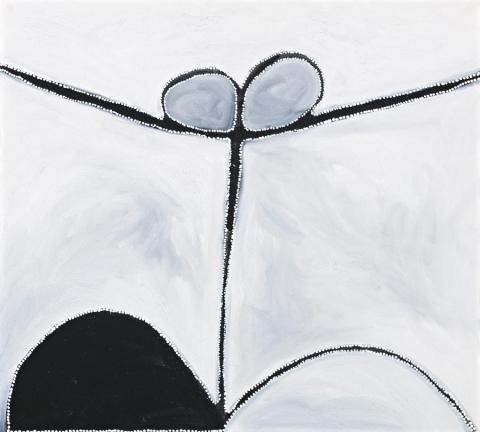MAD GAP, 2006
PADDY BEDFORD
natural earth pigments and synthetic binder on linen
122.0 x 135.0 cm
initialled verso: PB
inscribed verso: title and Jirrawun Arts cat. PB 3-2006-238
Jirrawun Arts, Kununurra
Private collection, Western Australia
Paddy Bedford, Museum of Contemporary Art, Sydney, 6 December 2006 - 15 April 2007; Art Gallery of Western Australia, Perth, 12 May - 22 July 2007; Bendigo Art Gallery, Victoria, 11 August - 16 September 2007, University of Queensland Art Museum, Brisbane, 16 November 2007 - 2 March 2008
Storer, R., Paddy Bedford, Museum of Contemporary Art, Sydney, 2006, pp. 105, 158 (illus.)
A consummate example of Paddy Bedford’s later works, Mad Gap elegantly demonstrates the artist’s mastery of tonal variation and a painterly technique uniquely his own. Unlike earlier works which rely upon form to define positive and negative space, Bedford’s handling of ochre here results in a tactile and densely gestural surface of considerable atmospheric quality. The two central voids within the composition are filled with a turbulent light and shade, itself contained within a vertiginous space which alludes to the steep escarpments of Bedford’s country.
As noted by Michiel Dolk, much of the compositional structure which underpins the work of artists from Bedford’s generation ‘stems from the memory of sites and features of the landscape corresponding with stories of the ngarranggarni, which form an evolving repertoire of designs or motifs.’1 Whilst most paintings of the Mad Gap site by other artist’s are concerned with a Gija myth of how the moon (garnkeny) brought death into the world, Bedford resists conventional interpretations dependent on narrative and place.
Rather we are drawn into the sublime through an elegant manipulation of motif, which is based upon the myths of creation and origin though firmly tethered in the present tense. As Dolk succinctly concludes, ‘While registering the history of all that followed in the killing times and station times, PB’s (Bedford) paintings now imaginatively recreate this landscape as a pictorial space in which the memory of ritual is submerged and renewed within the theatre of contemporary art.’2
1. ‘Are We Strangers in this Place?’ in Michael, L., Paddy Bedford, Museum of Contemporary Art, Sydney 2006, p. 40
2. ibid. p. 45
MERRYN SCHRIEVER
